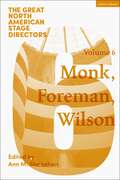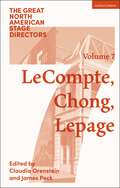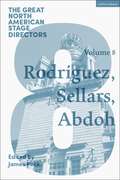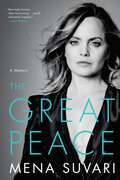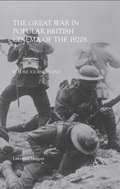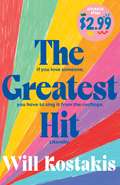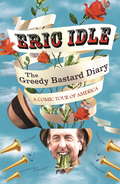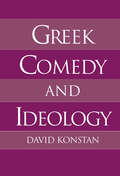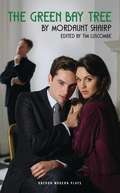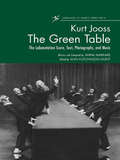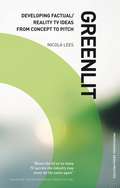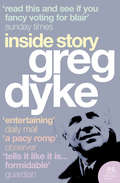- Table View
- List View
Great North American Stage Directors Volume 6: Meredith Monk, Richard Foreman, Robert Wilson (Great Stage Directors)
by Professor James PeckThis volume assesses the work of Meredith Monk, Richard Foreman, and Robert Wilson, three artists who have revolutionized the craft of directing and the art of theatre in both related and unique ways. Though their early artistic backgrounds differ, ranging from architecture, music and dance to writing, they are similar in that none of them began their career as a director per se or received formal training as such. They each assumed the director's role based on the demands of their complex artistic visions, which combine art forms, but resist synthesis, finding expression in the differences and tensions between the forms. The essays in this volume explore how these auteur directors combine text, movement, film, sound and music, installation and visual arts to achieve their visions, employing multi-perceptual modes to evoke full and rich theatrical experiences. The Great North American Stage Directors series provides an authoritative account of the art of directing in North America by examining the work of twenty-four major practitioners from the late 19th century to the present. Each of the eight volumes examines three directors and offers an overview of their practices, theoretical ideas, and contributions to modern theatre. The studies chart the life and work of each director, placing his or her achievement in the context of other important theatre practitioners and broader social history. Written by a team of leading experts, the series presents the genealogy of directing in North America while simultaneously chronicling crucial trends and championing contemporary interpretation.
Great North American Stage Directors Volume 7: Elizabeth LeCompte, Ping Chong, Robert Lepage (Great Stage Directors)
by Professor James PeckThis volume focuses on three artists who embrace media and technology as essential elements of their theatrical expression: Elizabeth LeCompte, Ping Chong, and Robert Lepage. Diverse in their aesthetic interests, they nevertheless share an approach to directing that includes technological media on stage as central to a rigorously crafted production concept. Technological elements live alongside and negotiate with the theatre's human players, disclosing, shaping, and even intruding on the dramas they enact. The essays in this volume explore how all three directors have provided decisive responses to a question that has dogged the theatre for at least the last century: what relationship can theatre, an art form grounded in live, ephemeral, expression, have to technology?The Great North American Stage Directors series provides an authoritative account of the art of directing in North America by examining the work of twenty-four major practitioners from the late 19th century to the present. Each of the eight volumes examines three directors and offers an overview of their practices, theoretical ideas, and contributions to modern theatre. The studies chart the life and work of each director, placing his or her achievement in the context of other important theatre practitioners and broader social history. Written by a team of leading experts, the series presents the genealogy of directing in North America while simultaneously chronicling crucial trends and championing contemporary interpretation.
Great North American Stage Directors Volume 7: Elizabeth LeCompte, Ping Chong, Robert Lepage (Great Stage Directors)
by Professor James PeckThis volume focuses on three artists who embrace media and technology as essential elements of their theatrical expression: Elizabeth LeCompte, Ping Chong, and Robert Lepage. Diverse in their aesthetic interests, they nevertheless share an approach to directing that includes technological media on stage as central to a rigorously crafted production concept. Technological elements live alongside and negotiate with the theatre's human players, disclosing, shaping, and even intruding on the dramas they enact. The essays in this volume explore how all three directors have provided decisive responses to a question that has dogged the theatre for at least the last century: what relationship can theatre, an art form grounded in live, ephemeral, expression, have to technology?The Great North American Stage Directors series provides an authoritative account of the art of directing in North America by examining the work of twenty-four major practitioners from the late 19th century to the present. Each of the eight volumes examines three directors and offers an overview of their practices, theoretical ideas, and contributions to modern theatre. The studies chart the life and work of each director, placing his or her achievement in the context of other important theatre practitioners and broader social history. Written by a team of leading experts, the series presents the genealogy of directing in North America while simultaneously chronicling crucial trends and championing contemporary interpretation.
Great North American Stage Directors Volume 8: Jesusa Rodriguez, Peter Sellars, Reza Abdoh (Great Stage Directors)
by Professor James PeckThe three directors gathered in this volume all approach theatre-making in part as an act of citizenship. Jesusa Rodríguez, Peter Sellars, and Reza Abdoh differ markedly in many important respects, but they all come to the theatre as an intervention in the public sphere. Rodríguez, Sellars, and Abdoh blend a spirit of social critique with acts of democratic community building. These essays examine how theatre, for them, is not a sphere of aesthetic experience insulated from the divisions, antagonisms, and alliances of a conflicted society. It is a way to forge fleeting but consequential communities that might reverberate through that society and affect its future development.The Great North American Stage Directors series provides an authoritative account of the art of directing in North America by examining the work of twenty-four major practitioners from the late 19th century to the present. Each of the eight volumes examines three directors and offers an overview of their practices, theoretical ideas, and contributions to modern theatre. The studies chart the life and work of each director, placing his or her achievement in the context of other important theatre practitioners and broader social history. Written by a team of leading experts, the series presents the genealogy of directing in North America while simultaneously chronicling crucial trends and championing contemporary interpretation.
Great North American Stage Directors Volume 8: Jesusa Rodriguez, Peter Sellars, Reza Abdoh (Great Stage Directors)
by Professor James PeckThe three directors gathered in this volume all approach theatre-making in part as an act of citizenship. Jesusa Rodríguez, Peter Sellars, and Reza Abdoh differ markedly in many important respects, but they all come to the theatre as an intervention in the public sphere. Rodríguez, Sellars, and Abdoh blend a spirit of social critique with acts of democratic community building. These essays examine how theatre, for them, is not a sphere of aesthetic experience insulated from the divisions, antagonisms, and alliances of a conflicted society. It is a way to forge fleeting but consequential communities that might reverberate through that society and affect its future development.The Great North American Stage Directors series provides an authoritative account of the art of directing in North America by examining the work of twenty-four major practitioners from the late 19th century to the present. Each of the eight volumes examines three directors and offers an overview of their practices, theoretical ideas, and contributions to modern theatre. The studies chart the life and work of each director, placing his or her achievement in the context of other important theatre practitioners and broader social history. Written by a team of leading experts, the series presents the genealogy of directing in North America while simultaneously chronicling crucial trends and championing contemporary interpretation.
The Great Peace: A Memoir
by Mena SuvariA memoir by award-winning actor Mena Suvari, best-known forher iconic roles in American Beauty, American Pie, and Six Feet Under.The Great Peace is a harrowing, heartbreaking coming-of-age story set in Hollywood, in which young teenage model-turned-actor Mena Suvari lost herself to sex, drugs and bad, often abusive relationships even as blockbuster movies made her famous. It's about growing up in the 90s, with a soundtrack ranging from The Doors to Deee-Lite, fashion from denim to day-glo, and a woman dealing with the lasting psychological scars of abuse, yet knowing deep inside she desires so much more from life.Within these vulnerable pages, Mena not only reveals her own mistakes, but also the lessons she learned and her efforts to understand and grow rather than casting blame. As such, she makes this a timeless story of girl empowerment and redemption, of somebody using their voice to rediscover their past, seek redemption, and to understand their mistakes, and ultimately come to terms with their power as an individual to find a way and a will to live—and thrive. Poignant, intimate, and powerful, this book will resonate with anyone who has found themselves lost in the darkness, thinking there's no way out. Ultimately, Mena's story proves that, no matter how hopeless it may seem, there's always a light at the end.
The Great War in American and British Cinema, 1918–1938: Art Amidst the Ashes (Palgrave Studies in the History of the Media)
by Ryan CoppingThis book recounts the reception of selected films about the Great War released between 1918 and 1938 in the USA and Great Britain. It discusses the role that popular cinema played in forming and reflecting public opinion about the War and its political and cultural aftermath in both countries. Although the centenary has produced a wide number of studies on the memorialisation of the Great War in Britain and to a lesser degree the USA, none of them focused on audience reception in relation to the Anglo-American ‘circulatory system’ of Trans-Atlantic culture.
The Great War in Popular British Cinema of the 1920s: Before Journey's End
by L. NapperThis book discusses British cinema's representation of the Great War during the 1920s. It argues that popular cinematic representations of the war offered surviving audiences a language through which to interpret their recent experience, and traces the ways in which those interpretations changed during the decade.
The Greatest Comic Book of All Time: Symbolic Capital and the Field of American Comic Books (Palgrave Studies in Comics and Graphic Novels)
by Bart Beaty Benjamin WooBart Beaty and Benjamin Woo work to historicize why it is that certain works or creators have come to define the notion of a "quality comic book," while other works and creators have been left at the fringes of critical analysis.
The Greatest Hit: Australia Reads Special Edition
by Will KostakisPeople look at Tessa and see her biggest mistake.While everyone else her age is taking their bold first steps into adulthood, she's just trying to outrun a song that went viral when she was fourteen.But now - an opportunity. A profile as one of The Five Most Forgettable Internet Celebrities of the Decade So Far gives her the chance to right a wrong, and the courage to sing her greatest hit as it was originally written. But will it be enough to win back the person she hurt?An exclusive story for AUSTRALIA READS from one of Australia's leading YA writers.
Greed (BFI Film Classics)
by Jonathan RosenbaumGreed is a legendary film begun in 1923. It was to have been Erich von Stroheim's masterwork, but his colossal ambitions were to be his undoing. His obsession with realistic detail and determination to extract every ounce of drama from his source, Frank Norris's novel McTeague, stretched the shooting schedule to inordinate lengths, resulting in a film which ran for over seven hours. Jonathan Rosenbaum has made a meticulous study of all the sources. In a fascinating piece of detective work, he reconstructs the history of one of cinema's greatest ruins.
Greed (BFI Film Classics)
by Jonathan RosenbaumGreed is a legendary film begun in 1923. It was to have been Erich von Stroheim's masterwork, but his colossal ambitions were to be his undoing. His obsession with realistic detail and determination to extract every ounce of drama from his source, Frank Norris's novel McTeague, stretched the shooting schedule to inordinate lengths, resulting in a film which ran for over seven hours. Jonathan Rosenbaum has made a meticulous study of all the sources. In a fascinating piece of detective work, he reconstructs the history of one of cinema's greatest ruins.
The Greedy Bastard Diary: A Comic Tour of America
by Eric IdleEric Idle, the legendary star of Monty Python fame, takes fans on a deeply personal and hilarious whirlwind tour around America.'I still feel somewhat nervous encroaching on the Palin territory of writing a travel diary based on a journey ... though it is true, I reason, that all the Pythons have been involved in documentaries. So this must be a Python thing. What is this urge to probe and examine by ex-comedians? Are they tired of dressing up as women? Surely not.' - Eric IdleThe man who brought you the anthems 'Always Look on the Bright Side of Life' and 'Sit on my Face' shows his naughty bits - and much more! As he crossed the US on The Greedy Bastard Tour, Eric Idle kept a diary on the Monty Python website updating fans with his experiences, insights and observations. Inspired by those blogs, THE GREEDY BASTARD DIARY is an honest, hysterical and moving book - part travelogue, part memoir - that chronicles those 80 days on the road, offering Idle's thoughts on his career, personal life and the country he now calls his home. Reflective, ironic, and stamped with his renowned wit, this illuminating work takes readers on a personal tour with the legendary star and offers an intimate, close-up look inside the man as never before.
Greek Tragedy and the Contemporary Actor
by Zachary Dunbar Stephe HarropThis book offers a provocative and groundbreaking re-appraisal of the demands of acting ancient tragedy, informed by cutting-edge scholarship in the fields of actor training, theatre history, and classical reception. Its interdisciplinary reach means that it is uniquely positioned to identify, interrogate, and de-mystify the clichés which cluster around Greek tragedy, giving acting students, teachers, and theatre-makers the chance to access a vital range of current debates, and modelling ways in which an enhanced understanding of this material can serve as the stimulus for new experiments in the studio or rehearsal room. Two theoretical chapters contend that Aristotelian readings of tragedy, especially when combined with elements of Stanislavski’s (early) actor-training practice, can actually prevent actors from interacting productively with ancient plays and practices. The four chapters which follow (Acting Sound, Acting Myth, Acting Space, and Acting Chorus) examine specific challenges in detail, combining historical summaries with a survey of key modern practitioners, and a sequence of practical exercises.
The Green Bay Tree (Oberon Modern Plays)
by Mordaunt Shairp Tim Luscombe‘I hope I shan’t meet you one day in Piccadilly with a painted face, just because you must have linen sheets’ A beautiful young man is forced to choose between the love of his fiancée and the lifestyle of his male admirer.
The Green Hollow
by Owen SheersIn 1966 a coal slag heap collapsed on a school in south Wales, killing 144 people, most of them children. Poet Owen Sheers has given voice to those who still live in Aberfan, the pit village in which tragedy struck, and using their collective memories has created a striking work of poetic power.Sheers set out to paint a portrait not just of what happened, but also of what was lost. What was Aberfan like in 1966? What were the interests of the people, the social life, the sporting obsessions, the bands of the day? What was the deeper history of the place? Why had it become the mining village it was, and what had it been before the discovery of coal under its soil? Perhaps most significantly, what was Aberfan like today?The Green Hollow is a historical story with a deeply urgent contemporary resonance: a story of what can happen when a community is run by a corporation. It is also a story known along generational rather than geographic borders. Based on the BBC One production, The Green Hollow is a beautifully rendered picture of a time and place - and a life-altering event whose effects are felt to this day.
The Green Screen Handbook: Real-World Production Techniques
by Jeff FosterThe Green Screen Handbook, Second Edition is a comprehensive how-to manual that walks you through the many integral techniques required in preproduction, production, and postproduction to use green screen effectively. Step-by-step instruction and time-saving tips cover matting and keying basics; lighting and digital camera essentials; setups using fabric, portable background panels, and paint; broadcast TV hardware switchers; professional HD and major motion picture compositing; multi-colored screen composites; directing storyboards and talent; working with virtual sets; motion tracking; and much more. Additionally, this new edition has been updated to include: Coverage of the latest digital camera technologies, lighting gear, and compositing and editing software Advice on using apps for portable devices that will help you light and shoot better green screen Examples and case studies of real-world green screen and compositing projects in film and television productions An extensive companion website (www.focalpress.com/cw/foster) featuring downloadadble project files and streaming video tutorials You can’t afford to miss out! The Green Screen Handbook, Second Edition is a one-stop shop for all of your green screen solutions.
The Green Screen Handbook: Real-World Production Techniques
by Jeff FosterThe Green Screen Handbook, Second Edition is a comprehensive how-to manual that walks you through the many integral techniques required in preproduction, production, and postproduction to use green screen effectively. Step-by-step instruction and time-saving tips cover matting and keying basics; lighting and digital camera essentials; setups using fabric, portable background panels, and paint; broadcast TV hardware switchers; professional HD and major motion picture compositing; multi-colored screen composites; directing storyboards and talent; working with virtual sets; motion tracking; and much more. Additionally, this new edition has been updated to include: Coverage of the latest digital camera technologies, lighting gear, and compositing and editing software Advice on using apps for portable devices that will help you light and shoot better green screen Examples and case studies of real-world green screen and compositing projects in film and television productions An extensive companion website (www.focalpress.com/cw/foster) featuring downloadadble project files and streaming video tutorials You can’t afford to miss out! The Green Screen Handbook, Second Edition is a one-stop shop for all of your green screen solutions.
The Green Table: The Labanotation Score, Text, Photographs, and Music
by Ann Hutchinson Guest* Score, photographs, and production details of one of this century's best-loved ballets * Includes rare archival material * Packaged with audio CD This work brings together the complete dance score of The Green Table--one of the most famous ballets of the 20th century--in Labanotation, along with music notation for the piano accompaniment and a complete recording of the accompaniment on CD. It also includes several essays about the work and its genesis, and many historic production photographs. This book is an important item for all colleges with dance programs to own in their libraries and for scholars interested in the study of contemporary dance.
The Green Table: The Labanotation Score, Text, Photographs, and Music
by Ann Hutchinson Guest* Score, photographs, and production details of one of this century's best-loved ballets * Includes rare archival material * Packaged with audio CD This work brings together the complete dance score of The Green Table--one of the most famous ballets of the 20th century--in Labanotation, along with music notation for the piano accompaniment and a complete recording of the accompaniment on CD. It also includes several essays about the work and its genesis, and many historic production photographs. This book is an important item for all colleges with dance programs to own in their libraries and for scholars interested in the study of contemporary dance.
Greenlights: Raucous stories and outlaw wisdom from the Academy Award-winning actor
by Matthew McConaugheyFrom the Academy Award®-winning actor, an unconventional memoir filled with raucous stories, outlaw wisdom, and lessons learned the hard way about living with greater satisfaction.I've been in this life for fifty years, been trying to work out its riddle for forty-two, and been keeping diaries of clues to that riddle for the last thirty-five. Notes about successes and failures, joys and sorrows, things that made me marvel, and things that made me laugh out loud. How to be fair. How to have less stress. How to have fun. How to hurt people less. How to get hurt less. How to be a good man. How to have meaning in life. How to be more me.Recently, I worked up the courage to sit down with those diaries. I found stories I experienced, lessons I learned and forgot, poems, prayers, prescriptions, beliefs about what matters, some great photographs, and a whole bunch of bumper stickers. I found a reliable theme, an approach to living that gave me more satisfaction, at the time, and still: If you know how, and when, to deal with life's challenges - how to get relative with the inevitable - you can enjoy a state of success I call 'catching greenlights.'So I took a one-way ticket to the desert and wrote this book: an album, a record, a story of my life so far. This is fifty years of my sights and seens, felts and figured-outs, cools and shamefuls. Graces, truths, and beauties of brutality. Getting away withs, getting caughts, and getting wets while trying to dance between the raindrops.Hopefully, it's medicine that tastes good, a couple of aspirin instead of the infirmary, a spaceship to Mars without needing your pilot's license, going to church without having to be born again, and laughing through the tears.It's a love letter. To life.It's also a guide to catching more greenlights-and to realising that the yellows and reds eventually turn green too. Good luck.
Greenlit: Developing Factual/Reality TV Ideas from Concept to Pitch (Professional Media Practice)
by Nicola Lees"Blows the lid on so many TV secrets" Tom Archer, Controller Factual, BBC"If every first-time producer read this before pitching a program, I guarantee a greater success rate" Gary Lico, President/CEO, CABLEready, USAIn recent years there has been an explosion of broadcast and cable channels with a desperate need for original factual/reality programming to fill their schedules: documentaries, observational series, makeover formats, reality competitions. Yet television executives receive a daily avalanche of inappropriate pitches from pushy, badly prepared producers. Only 1 in 100 proposals are considered worth a second look, and most commissioners never read past the first paragraph. Greenlit explains how to develop, research, pitch and sell your idea for any type of factual or reality television show. It gives the inside track on: - What channel executives are really looking for in a pitch- The life stories of hit factual shows such as The Apprentice, Deadliest Catch and Strictly Come Dancing- Advice from channel commissioners, development producers and on-screen talent on both sides of the Atlantic- Eleven steps that will increase your chance of winning a commissionIn a rapidly expanding TV market, Greenlit is packed with resource lists, sample proposals, case studies and exercises designed to boost your skills and develop commission-winning proposals.
Greenlit: The Professional Guide to Pitching Factual Shows (Professional Media Practice Ser.)
by Nicola Lees"Blows the lid on so many TV secrets" Tom Archer, Controller Factual, BBC"If every first-time producer read this before pitching a program, I guarantee a greater success rate" Gary Lico, President/CEO, CABLEready, USAIn recent years there has been an explosion of broadcast and cable channels with a desperate need for original factual/reality programming to fill their schedules: -documentaries, observational series, makeover formats, reality competitions. Yet television executives receive a daily avalanche of inappropriate pitches from pushy, badly prepared producers. Only 1 in 100 proposals are considered worth a second look, and most commissioners never read past the first paragraph. Greenlit explains how to develop, research, pitch and sell your idea for any type of factual or reality television show. It gives the inside track on: * What channel executives are really looking for in a pitch, * The life stories of hit factual shows such as The Apprentice, Deadliest Catch and Strictly Come Dancing* Advice from channel commissioners, development producers and on-screen talent on both sides of the Atlantic. * Eleven steps that will increase your chance of winning a commissionIn a rapidly expanding TV market, Greenlit is packed with resource lists, sample proposals, case studies and exercises designed to boost your skills and develop commission-winning proposals.
Greg Dyke: Inside Story
by Greg Dyke‘“How did a short bald, man with a speech impediment have such an impact?” How indeed? Like his life, “Inside Story” is a pacy romp. Honest and heartfelt, it should be required reading.’ Observer
